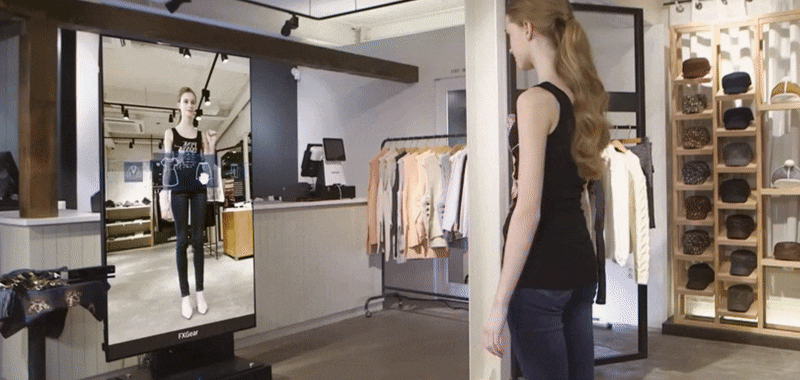Lululemon

Did Lululemon Just Become an Augmented Reality Company?
Canadian athletic apparel company Lululemon announced plans to acquire at-home fitness startup MIRROR for $500 Million. The product, which launched in 2018, is a wall mounted mirror that streams live and on-demand workout classes, as well as one-on-one personal training sessions. When looking into MIRROR, you see your form reflected back to you alongside a certified instructor who guides you through the exercises.
Image: MIRROR
To be clear, I don’t consider MIRROR to be an Augmented Reality experience… yet.
The deal presents a massive opportunity for MIRROR’s current hardware to be enhanced with AR, including extending Lululemon’s product sales with virtual try-on and shopping, both at home and in-store. An example of what this could look like is demonstrated in the video below by FXMirror from 2015.
Eyeing that cute Lululemon tank and yoga pants combo your instructor is wearing? Try it and similar styles on virtually from the comfort of your home. Snap a selfie in the outfit with MIRROR’s camera (MIRROR enables workout selfies) and send it to friends in your MIRROR network (a social aspect is already built into MIRROR’s technology). Loving it? Order it instantly from MIRROR in time for tomorrow’s one-on-one coaching session. (In June 2019, I wrote about using Apple Pay to instantly purchase products like glasses during AR try-on experiences.)
MIRROR’s technology currently recommends new classes to you each week based on your fitness goals and workout preferences. This could be expanded to include Lululemon product recommendations ranging from clothing to accessories to workout equipment, all personalized to you (and perhaps even customized to the biometrics shared with MIRROR).
In response to store closures amid the COVID-19 pandemic, Lululemon began offering a virtual personal shopping experience back in April via 30 minute video chat appointments on Zoom. The complimentary service is still available and could be further extended using AR and MIRROR to help you discover new gear, answer any questions you have, and make your purchase, all without leaving the MIRROR interface.
Lululemon virtual personal shopping
A common request among my retail industry clients is investigating and applying methods to mirror and evolve human to human interaction and connection with virtual technologies. MIRROR presents an appealing alternative to personal shopping video conference tools on our computers or mobile devices, where we’re typically cut off at our torso. By offering a full body experience in a format we’re already comfortable with when shopping (looking at ourselves in a physical mirror), where we can interact with sales associates live as though they are physically there with us, and paired with the possibilities for social integration, Lululemon has an incredible opportunity to define the future of shopping.
An AR enabled version of MIRROR could also become part of the in-store experience. As Lululemon stores begin to reopen around the world, health and safety precautions and measures are being put into place. Fitting rooms are sanitized after each use, and clothing tried on and not purchased (as well as any returns) are held back for 24 hours before being placed on the sales floor. Not feeling comfortable trying on clothing, but still want to see the item in person? A virtual try-on experience in-store using an AR-enabled MIRROR would be a welcomed solution.
MIRROR currently doesn't function as a touchscreen; the mobile app is required to select and control your workouts. To enable a more seamless shopping experience, the technology could expand to include gesture interaction directly with the MIRROR, a method already popular with numerous virtual try-on mirror experiences (as seen in the video above by AR Door using Microsoft Kinect in 2011 for Topshop). Contactless solutions are certainly an avenue to explore and one less surface to decontaminate during these times.
I find it surprising how little virtual try-on mirrors have evolved specifically for apparel over the past decade. Our industry has made huge leaps forward with AR on our faces, including virtual makeup and product accessories like glasses, as well as virtual footwear on our bodies by companies like Gucci, but for the most part, clothing doesn’t look realistic yet in these magic mirror experiences — it’s still very much 2D, with a “paper doll” type aesthetic, as Salvador Nissi Vilcovsky, CEO of Memomi, aptly described it to me.
“We didn’t push the fashion industry because it’s very limited, there are no assets for 3D. We can develop the most beautiful technology for this industry, but we will not have customers that will be able to leverage it because they don’t have the 3D asset of this jacket,” shared Vilcovsky. “We think that now the time is coming because we already have a few customers that started to provide us with 3D assets.”
With a major shift happening today towards digital fashion (led by companies like The Fabricant) and the acceleration of 3D asset production for virtual showrooms and fashion shows amid the pandemic, as well as the crossover with gaming and virtual goods, the quality of virtual try-on experiences will only get better with more realistic digital clothing options.
In a special webinar for Vogue sponsored by Snapchat and Gucci on luxury in AR, I had the opportunity to ask Carolina Arguelles Navas, Global Product Marketing Lead at Snapchat, about experimenting with AR clothes in Snapchat and how far away we are from seeing this virtual apparel on our body.
“I think that clothing, and especially putting it on your full body, is something that in the past has been a bit trickier to do to make it look very, very realistic. There are a lot of innovations that we are investing in in order for that to continue to evolve,” said Navas.
Sean Mills, Senior Director Content, on stage at Snap Partner Summit 2020 announcing “Move It”
Snap Original “Move It”
“We’re also investing in full body tracking. We actually announced at our Partner Summit the other week one of our premium content shows that are coming up on Snapchat. This show is about fitness and how it works is that it shows you a lot of fitness routines and dance routines and then it has an AR component where you can actually play along and dance along. It uses full body tracking to make sure you’re moving in the exact way you’re supposed to,” shared Navas, referencing the new Snapchat immersive AR dance show “Move It”.
Navas furthered, “And so this type of body tracking at such an incredible accurate degree is really the beginning for us to be able to start to move into a full body experience.”
Original content in the form of interactive shows, similar to Snapchat’s “Move It”, is something MIRROR and Lululemon could also develop in the near future, creating shows that not only keep you sweating digitally, but are shoppable too.
Lululemon may not be an AR company yet, but it would be amiss to not build out some of these capacities in the near future. (Brynn Putnam and Calvin McDonald: I’m very happy to discuss and explore the many possibilities here with you and your team)
Need expert help with your digital strategy? Learn more about my consulting services here.
Book me as a speaker for your next event.
Get your copy of “Augmented Human” (available worldwide in 5 languages) here.
Follow me on Twitter: I’m @ARstories








